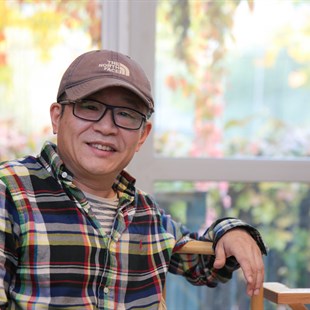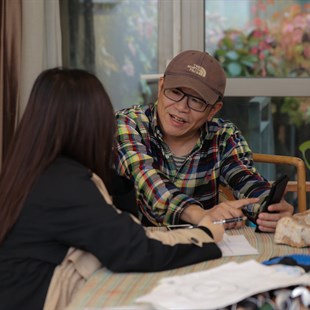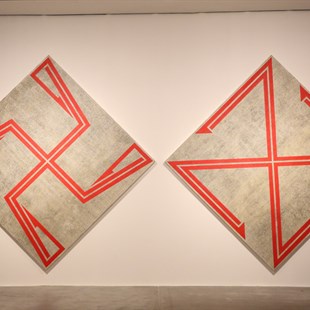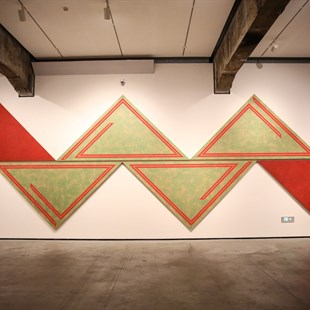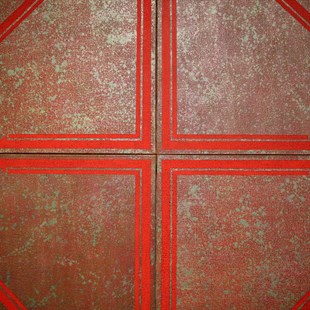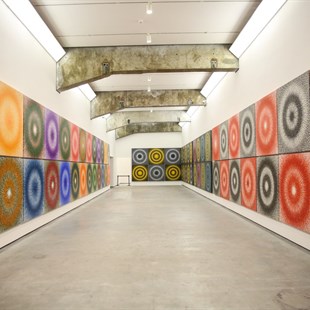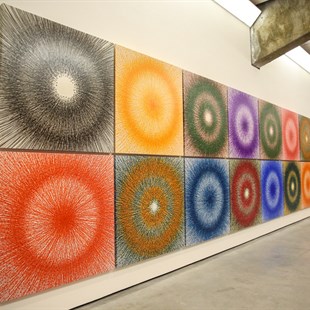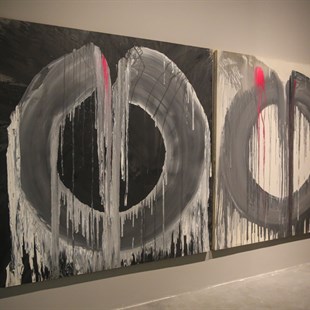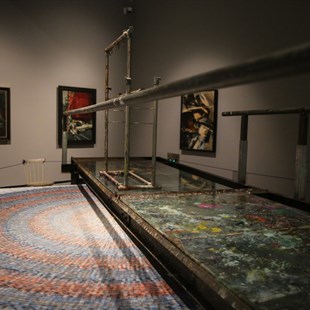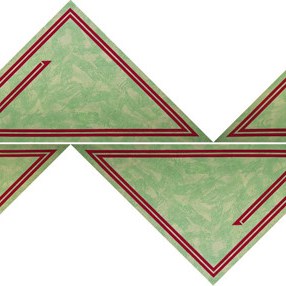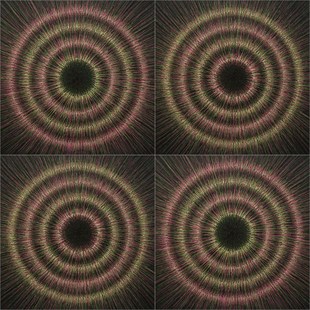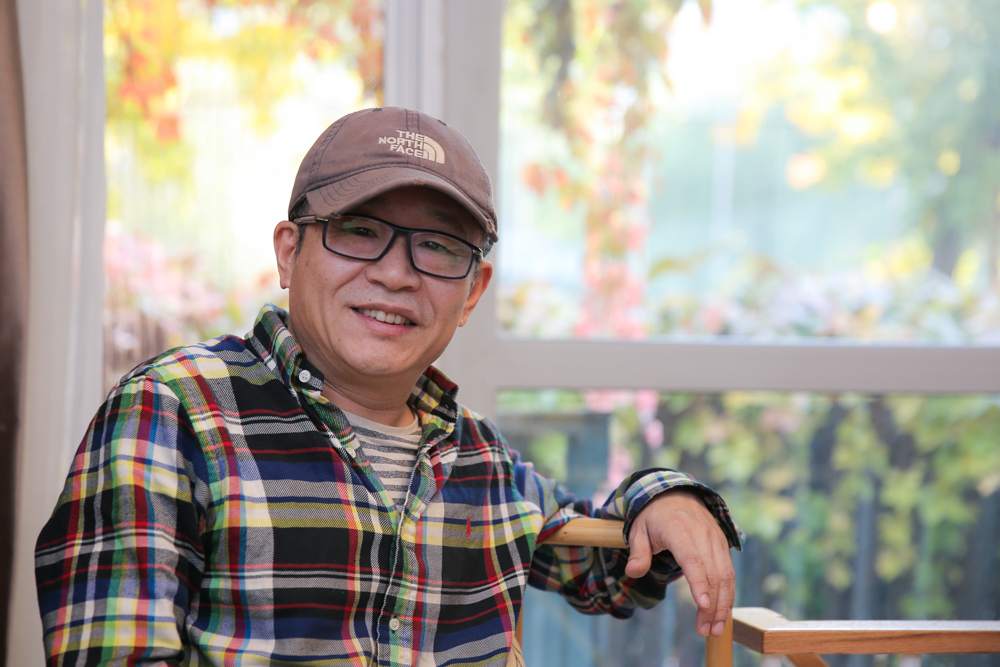
With the same size and creative technique, Meng Luding’s works have been created using similar form and content, why have they been presented in such a large scale? The exhibition “YUAN·MENG LUDING” was unveiled at Beijing Minsheng Art Museum, and it features over 120 works from Yuan Rate and Cinnabar series. It is the artist’s first large-scale exhibition since 2008.
When spectators step into the exhibition hall, they will be confronted with Meng’s latest series of Cinnabar. This series of work is highlighted with the traditional cultural meaning of cinnabar as its main visual color, and they are composed of multiple changes in geometric swastikas (Indian, Srivatsa). On the right and left galleries, over a hundred paintings from Yuan Rate series that the artist has created since 2017, are exhibited in a comparatively dense way. In the right gallery, 94 circular circles spread outward from the center to form a gorgeous color matrix space, which is full of visual tension.
If we want to read and try to find a narrative logic in front of Meng Luding’s paintings, we will definitely fail. Abstract art separates the individual’s perceptual survival experience while revealing the language of art in a refined, calm and rational abstract form. The colors and forms of Meng Luding’s paintings have approached our senses in a form of visual pleasure, and the artist painstakingly used almost the entire museum space to create this similar sensory experience for the viewers. To strengthen the sensual experience, the artist even moved the machine that he produced the Yuan Rate series to the museum. Meng Luding seems to have presupposed his audience, “viewers can observe abstraction from the concept of ‘machine’, or they can also focus on the form of painting from the perspective of colors and materials.” He believes that, “viewers might not be able to have a complete realization when they first see my works, but they will gradually detect the information of life and deities conveyed by them if they accumulate their visits, so that they will perceive and derive more profound meaning.”
It cannot be ignored that, the exhibition also highlights animation by the artist, 9 masterpieces from various periods of his transition, as well as a set of interviews and a documentary. We may get a glimpse of the working methods that the artist has been self-renewing for decades. Although they are set on the triangular edges of the main exhibition space, but for the artist who claims that” this exhibition is not a retrospective, as I am still developing, and I have not finished yet,” this might the best footnote of his unknown art.
The concept of “YUAN” in Meng Luding’s art has lasted for 31 years since the first series of Yuan State was shown in 1988. “YUAN” is also the concept that has been commonly used in most of Meng Luding’s works. Why is this exhibition entitled “YUAN”? For Meng Luding, each end of work seems to point directly to the beginning of a new attempt. From the beginning to the end of “YUAN”, in the rapid passage of time and replacement, the behavior that the artist has been endowed with by changing himself as if he has the ability to restart the meta-point of life.
Text by Yang Zhonghui, translated by Sue/CAFA ART INFO
Interview with Meng Luding
Interviewee: Meng Luding
Interviewer: Zhang Yizhi
Photographer: Hu Sichen
Translated and edited by Sue/CAFA ART INFO
Photo Courtesy of the Organizer and Artist
CAFA ART INFO: First of all, congratulations on your exhibition “YUAN·MENG LUDING”. Would you like to briefly introduce the exhibition? What’s the focus of your research and creation?
Meng Luding: Thanks. Actually, I have few solo exhibitions but I have participated in many group exhibitions. It’s been a decade since my last solo exhibition (at the Guangdong Museum of Art in 2008). Wang Huangsheng was the Director at that time and Gao Minglu also served as the curator. I hope that this exhibition will present my way of working and the appearance of my paintings. It focuses on two series in this decade, one is Yuan Rate and the other is the new series of Cinnabar. This time I want to present my Yuan Rate series completely, and then let everyone watch the beginning of my new series. One of the galleries is relatively dense as it is full of paintings from Yuan Rate series. I hope that the gallery presents everyone with a different visual experience. Everyone should feel dizzy when they enter. The machines exhibiting the Yuan Rate series are behind the main hall. Also included are nine old works, some masterpieces from each stage since my student period (since 1985). Also on display is a new 3D animation that I made specifically for this exhibition. The title is “Life”, specifically the image of men and women “walking” out of a circle, and that circle is also the basic schema of Yuan Rate.
I am trying to convey my whole context from 1985 to the present day through a visual thing. In addition, I also want to convey some basic elements of abstraction, they are the points, lines, planes, and my attention to time and space. In fact, they are shown in this work, it has dynamic visuals and sound. This time I conducted an interview with twenty-three people, including critics, artists, colleagues from the Central Academy of Fine Arts, and friends. Through the interviews, you can find different interpretations of my work. This is very interesting. I put it above the stairway to the door. In addition, there is a desk in the middle. There will be some old newspapers on the desk, and some things that have been published. The table revolves, so in this exhibition hall, because the easel paintings are basically static, these three places are revolving, and the machine is also revolving on the scene.
I have started to use the word “YUAN” actually since the exhibition of my paintings featured Yuan State in 1988, and it has actually been over 30 years that I have used this title. Later Yuan Rate also used this “Yuan”, and I also used “Yuan” in my series of Yuan Change and Yuan Ratio. Because I am interested in this “Yuan”, it is the concept of the initial, the concept of the beginning of life. Actually, in my works, whether they are figurative or expressionist, including those in Football, I emphasize vitality and a dynamic strength of life. Including later abstract things that are also dynamic. Yuan Rate is dynamic, dynamic is a trajectory of life, so this “Yuan” can also unify the state of my entire practices over the years. This is the reason I have chosen “YUAN” as the title. Moreover, “Yuan” has a starting feeling, and I keep throwing away, removing the original thing, overthrowing and starting again. Actually, it has something to do with this “Yuan”, because “Yuan” has greater openness.
CAFA ART INFO: During the“85’ New Wave Art Movement”, you were still a sophomore. When you created the famous work “In the New Age: The Inspiration of Adam and Eve”, which used a surreal method to show the metaphor “Adam and Eve” as a taboo inspiration. Why did you choose such a Westernized symbol as the theme? At the time, you were also a young man in your early 20s. This work also contained the word “new”. In what kind of state did you understand the new “85 trend”?
Meng Luding: I was a sophomore at the Oil Painting Department of the Central Academy of Fine Arts, and I rarely participated in national exhibitions. At that time, I wanted to draw a picture seriously, but I didn’t want to draw the kind of work I originally painted to participate in art exhibitions. At the end of the Cultural Revolution, the bruise literature was more popular, so everyone painted realism, but we wanted to draw something different from realism. However, because we learned realistic techniques, we later felt that the style of surrealism might be more suitable for our thinking. I wanted to draw a philosophical subject, and it seemed very “foreign”, so I chose a story in the Bible (Adam and Eve) eating forbidden fruit. In fact, the story we chose was also a misunderstanding, which was actually not the meaning of the Bible. The Bible does not mean to be open and broken. It has the concept of original sin. But because we were not Christians, we haven’t read the Bible, we just understood the story from outside the religion. I chose this because China just opened up its door to the outside world. To break through many imprisoned things, we chose this story from this aspect. Now it looks a bit like propaganda, as it is still a slogan-like theme and belongs to thematic painting. I actually think that the “new” is natural, because when an old thing is removed, when a new thing comes, everyone must use the word “new” to express new thinking, new inspiration, and a new era, they use “new” to compare with “old” things.
CAFA ART INFO: In the 1990s, you went to the German Karlsruhe National Academy of Fine Arts. Later, you went to the United States and did many years of research abroad. As early as the “85’ New Wave” period, that is, when you went to the Central Academy of Fine Arts in China and before you went abroad, you have already begun the exploration of abstract art, or have you been inspired a lot after you went abroad? In the process of accepting this new thing, is there any experience or thought that has a great influence on your later ideas?
Meng Luding: I went to Germany in April 1990 and wanted to study in Germany. Because I like German expressionism, I also paint expressionism and abstractism. Now it looks like “hot abstraction”. I then stayed and taught. In fact, I taught abstraction before I went abroad. In fact, many people now look at abstraction, but at that time there were few, and I had a lot of confused things within myself. I felt that many things were lacking in teaching, and I wanted to go out and see. There was a need for learning, from both myself and teaching. Considering the social situation at that time, I just wanted to go out and see what real abstract art was, including contemporary art. Actually, I think that the most important thing for artists engaged in art is to see good things, understand the local culture, including integration of people’s lives, and so on, so that they can really see what is behind the artistic presentation. For me, what impresses me is the classic things in museums. You have seen so many things. Behind them may be the ones we all mentioned now, such as the masters of Cubism and Abstraction. After constantly watching and comparing people, these leave a deep impression on me since their work can withstand scrutiny.
CAFA ART INFO: From the Affiliated School to the Oil Painting Department of the Central Academy of Fine Arts, you have had a solid tradition of training. You came from an academic class, and some critics mentioned that when you use the Yuan Rate method, it is equivalent to his previous training which has basically returned to zero, which requires a lot of courage. How do you view this matter yourself, from realism to abstraction, it is suddenly changed through some works? Have you experienced the process of self-torture and confusion? Is this a loss for you? How do you coordinate this experience?
Meng Luding: It should not be a loss to me. In fact, I never regret it. Even if I am entangled and painful, I will not feel lost. Many things are like this. For some people, some things are very heavy and entangled. For some people, it may be nothing. It is an instinct, either personality or will. People pursue different things. It seems to me that a lot of things are nothing, including those of scientific background. If I do not like it, I will naturally throw it away.
Because technology has always been less appealing to me, including “basic skills.” I think the most important thing for people to do in art is to face reality. When you like it, you may forget something. You pursue what you like and synchronize it. If you are always curious about new things, then naturally you must discard the old things. I think this is a particularly natural transformation process for me now. For some people, they cannot afford to lose their previous burden. I think it’s all natural, but then thinking about it takes a lot of courage for some people. These changes lie in rational judgment and emotional input.
CAFA ART INFO: In the latest Cinnabar series, it is not difficult to find that Cinnabar is a “Chinese” material. Do you use it for creation? Does this highlight some material characteristics of Chinese abstract art? In addition, we will inevitably overlap with the pulse of Chinese traditional culture, add the abstract conceptual elements of “Confucianism and Buddhism” and turn to metaphysical description and discussion. What do you think is the difference between Chinese abstract art and abstract art in foreign countries? Or do you reject such a formulation and think that there is no distinction between abstract art?
Meng Luding: As a Chinese national, it is natural to bring some Chinese culture, language, thinking, even into daily life, there is no need to deliberately emphasize this though. Because deliberately emphasizing is sometimes untrue, so I don’t want to, and sometimes it’s easy to get it wrong. I first object to putting the word “Chinese” in front of abstract art. Because I am opposed to nationalism and state allegiance, this is what I have always opposed. I am even more opposed to being confined to one country, for example, everything is Chinese art. Although cinnabar is a traditional Chinese material, I am not flaunting or returning to tradition. I use this material accidentally, because a friend of mine who painted Chinese painting recommended me to use cinnabar. The colors of Chinese paintings are few. I asked him which color was the brightest. He said that it was cinnabar and stone green, so I chose to use cinnabar to make the Yuan Rate series. Some people say that cinnabar can ward off evil spirits. I didn’t care about that at the time because I think there are so many legends in China.
Last summer, a child of my friend who over two years old, didn’t enter his mother’s room. Everyone thought it was strange. The child said that there was a big devil in the room and he would not go in. At that time, I thought this was very strange. I wanted to do an experiment and gave them the painting of Cinnabar for their house. Then the children went in the next day, saying that the big devil had left, and they walked out in line. After I heard it, my scalp was numb. I asked his mother some time ago. Was he still going in? She said that now there was no obstacle in entering the room. I only knew then that cinnabar can really drive such an action! Of course, I did not paint Cinnabar for this reason. I think that using a material to express a concept, “exorcising ghosts and evil spirits” is also very much needed at the moment, as the “evil spirit” around us is too heavy. So I hope that through one material, people can create a kind of meditation through visual images and materials, and open up another space. At least everyone has this consciousness. There is such a system and an opportunity. This is what I want to achieve when I create my work. Regardless of whether it is mysticism or spirituality, I think it is something that art wants to promote. This is why I am painting Cinnabar, and I should paint it for a while, hoping to fully open its visual presentation, to create a space and field through different channels and angles, so that people can meditate before painting.
Actually, foreign artists are also studying these things, because the material of cinnabar may have made some sacrifices or have some other uses in the West. I met a German professor who specialized in this color. He wanted to restore the ancient colors, using special collection methods and refining methods to restore them. Among them are cinnabar and blue, which is more pure than Klein blue. The Taoist alchemists used them. I think these colors really have a psychic feeling. Probably because I am 50 years old now and I started to “know my destiny”. I didn’t have such feelings before, but now I am curious about life and another world. In addition, I think that when I use the machine to draw Yuan Rate, I actually give the concept to the machine and produce a visual thing through the operation of the machine. I now want to give ideas a color and release an energy. Actually, the two series of Cinnabar and Yuan Rate have the same internal concepts.
CAFA ART INFO: You wrote an article entitled “The Process of Purification” very early on and put forward the slogan of “purification language”. Everyone summarizes you in the scope of “Abstract Artist”, but in fact you have been breaking through traditions. What do you think of this “tag”? Would you like to change your perspective to label and categorize artists?
Meng Luding: Yes, the slogan of “purified language”. This label is the same as nationalism, abstractism, and state allegiance. In fact, it is negative for me because “individuals” are the most important thing. The artist does not first look at himself according to the label, but first looks at the artist from an individual perspective. The same is true for abstraction. Although there is some interest in abstraction now, many people have simplified abstraction. Many artists who paint abstract paintings are labeled as abstract artists. In fact, he does not object to this simplification. If he goes on like this, it will become narrower and narrower. No one wants to go into a dead end, but there is no way because everyone can only discuss issues in such a scope. In fact, each artist is different in the abstract group, and it is not a modernist abstraction in the traditional sense. Or their works are not some of them, so take this slowly. Tags are labels, but artists will do whatever they like to do.
I have also made constant breakthroughs. When many things are perfect, then there will be some new breakthroughs. This is also the value of life. It is a process in itself. If the process is single, this life is meaningless. I am also interested in animation now, but when I am interested in new things, I am particularly afraid of falling into being fashionable, and fashion is superficial.
CAFA ART INFO: You mentioned the developmental history of abstract art and the process of its coming to China. Abstract art was born more than 100 years ago. It entered China in the 1930s, but was affected by ideology after 1949. It is considered to be “bourgeois art”, and only after the “85’ New Wave” did it regained attention. At this time, the resumption of “abstract” in the art world is different from that of the year (when it entered in the 1930s). Is “abstract” still alive today? Looking at the longer-term historical path, what kind of existence does abstract art have now? Especially affected by cross-professional and new technologies?
Meng Luding: There are still differences. The 1930s belonged to the Republic of China. At that time, art was relatively loose. Basically, for example, the doctrines, activities, and ideological trends generated in Europe would soon arrive in Shanghai, which was basically synchronous. At that time, abstract art naturally came in with the naturalist movement.
Abstraction came in the 1980s and was not the same as the 1930s, because we had experienced the Cultural Revolution. The Cultural Revolution criticized that abstract art was something of bourgeois liberalization. It was suppressed in the school and in society, so when it came in, the art world called for an abstract form and abstract beauty to come in. Abstraction has existed since the 1980s, and now I think it is different. Abstraction has been ignored at the edge. The reason why it is slightly valued now is because of the political pop and market hype some time ago, the price of abstract works is very low. From a certain point of view, abstraction is still very “clean”. In addition, there is no specific symbol in the abstract work. It is politically secure, which is absurd and becomes a form of political security.
In fact, I think it is a misunderstanding. The main reason is that after a period of time, Chinese contemporary art has not studied enough modernism. Everyone has to come back to make up for this lesson, just like me as I am now returning to the Central Academy of Fine Arts as the teacher in charge of the Fifth Studio, and I will arrange to supplement the lesson of “Modernism” in teaching. In fact, the entire society needs it. Without such a study of formalism and training of vision, it would be impossible to achieve a pure state in the world language. It is expressed in such a precise and appropriate state, so I think the most important thing for abstraction is that we have a lot of things to supplement it.
The practical machine or cinnabar or other materials and tools, in fact, I just expressed it from a new angle, in a free method. There is nothing good or bad about art. For you personally, if you want to express something, you create it. There are no rules. There may be new tools and new ways of expression, and maybe it will bring people a new view and new visual experience. Therefore, I broaden the scope of abstract expression from this perspective. Originally, the abstractions of modernism were basically oil paintings. There was also painting nature in oil paintings, and the harmony of colors. Abstract art has developed to the extreme after it reaches minimalism. How should new abstraction develop? It’s getting harder and harder, so everyone needs to be experimental and break through the original constraints. Don’t define what abstraction is like, and no one can define what abstraction is. Maybe a new abstraction happens to be in an anti-abstract form.
Oil paintings, prints, sculptures, and Chinese paintings are all mediums. Now we use the medium to divide and improve, which is actually a relatively backward painting method. But there is no way. It is just such a model that was originally formed and it is difficult to change. But in fact, the artist himself is not too constrained by the media. In order to express it, there are various ways. I can use sculpture, three-dimensional, easel painting, sound, high-tech, which is no longer a constraint in itself.
CAFA ART INFO: The Fifth Studio of the Oil Painting Department of the Central Academy of Fine Arts, which you just mentioned, was established in 2015, focusing on research and promotion of abstract art teaching and exploration. In terms of teaching, is there a difference in the pattern of learning abstract art? Is it rooted in the large system of the Chinese oil painting department, starting from realism, or directly training abstract artists, focusing on shaping and guiding each of them to form their own abstract language? From the perspective of current students, what is different about today’s young artists? Is it similar to your strength in those years?
Meng Luding: We did not start with figurative work. This was already learned in the fundamental department. Students will quickly change their habits and “clear” figurative thinking within a week or two after they enter the studio. When you enter the studio, you have to completely break, destroy, and reconstruct. In fact, realism is an obstacle and resistance for some people, but it is not an obstacle for other people. It can suspend a lot of realistic things. Many graduates of the Affiliated School to CAFA have received the realism part very well. You won’t lose the effort, you can keep it to do something new. The current students are completely different from the previous ones from the perspective of strength. The whole environment is different. At the time of the “85’ New Wave”, China’s material level was still relatively low. It just ended from the Cultural Revolution. At that time, there was a state of depression, and everything was felt from the beginning. Those in our generation after the 60s had a particularly heavy sense of mission and responsibility. There is no such thing after the 1990s, and at that time we were affected by the social system, our sense of collectivism was particularly strong, and everything was “movement, revolution.”
Over the years, people have become more mature and independent, and they have paid more attention to their individuality and paid attention to themselves. At that time, we were struggling for this thing for a long time, so I think the young students are not in the same state as us at that time. This is also good, because the starting point will be very high, starting from the individual rather than the collective, and completing the social things, thinking about society from an individual perspective, not from a group perspective. I don’t think there is such a thing as collectivism, it is progress.


